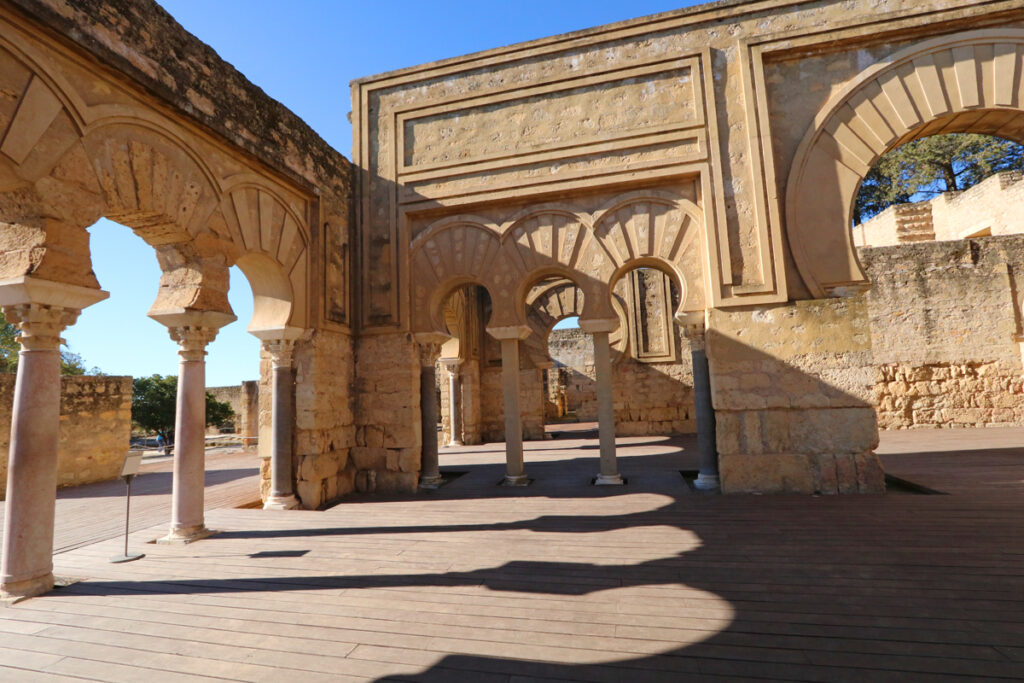Why you should visit Cordoba’s Medina Azahara.
Medina Azahara (or Madinat al-Zahra) is a UNESCO World Heritage site located just outside Córdoba. It’s a place you have to see when visiting Córdoba (and getting there is quite easy as I’ll describe in the post).

What is Medina Azahara?
Medina Azahara was the new capital of the Caliphate of Córdoba. Built starting in 940 AD, it would be the center of Muslim rule on the Iberian peninsula. A series of events however led to the city only surviving 75 years.
Today the site lies mostly in ruins and is an active archaeological site, the largest archaeological site in Spain. In 2018 it was named a UNESCO World Heritage site.

History of Medina Azahara
When the Moors took over the Iberian peninsula in 711 AD, they established Córdoba as their capital. In 756, Abd al-Rahman I, a member of the Umayyad dynasty, ruptured relations with the ruling Abbasid Caliphate in Baghdad (who had defeated the Umayyads 6 years previous). He became Emir of Córdoba.
During the next 150 years there was a lot of infighting among the different Muslim leaders in the area, many of whom had different loyalties.
In 912 AD, Abd al-Rahman III took power. His goal was to consolidate the various kingdoms and to centralise power in Córdoba. He achieved this principally by force. By doing so, he gained control of most of the Iberian peninsula. In 929 Abd al-Rahman III declared himself “Caliph” – or ruler of the Islamic World.
As the new Caliph and the ruler of the Caliphate of Córdoba, Abd al-Rahman III decided to build a new city. That’s what Caliphs did. This was how Medina Azahara came to be.
Construction of Medina Azahara started in 940 AD and continued through his rule (he died in 961). It continued through the reign of his son Al-Hakam II. Palaces, reception halls, mosques, government offices, gardens, baths, barracks and living quarters for townspeople were all built.
In 976 Al-Hakam II died from a stroke. From that moment on, Medina Azahara stopped being used a center of government. It would eventually be plundered in a civil war (1010 – 1013) and the remains left abandoned. By 1031 the Caliphate of Córdoba had crumbled and been replaced by taifas (independent Muslim Kingdoms).
Altogether, Medina Azahara lasted barely 75 years.

Visiting the site of Medina Azahara
Medina Azahara opening hours on the official website. A ticket costs 1.50 Euros (but is free for European citizens)
If you don’t have your own transport, you can take the bus to the site. It leaves from Central Córdoba twice a day Tuesday to Sunday (at 10 am and 10:45am) and costs 10 Euros return. You can book the bus and see details here. Medina Azahara is about 8km out of Córdoba so it’s about a 15-minute bus ride.
The 10 am bus returns at 13:30, the 10:45 bus returns at 14:15
Note: always check the websites for the most recent information.

When going to Medina Azahara, you’ll park outside the Visitor’s Center (where there’s the ticket center and museum). That includes if you’ve gotten there by bus. You can buy your tickets there and see the museum if you wish (or leave it to the end as we did).
To get from the Visitor’s Center, you take a shuttle bus (3 Euros return) from the parking lot. It takes you up the hill (3 km, about a 10-minute ride) to the archaeological site. From there you’ll be walking around and wandering around the ruins (below).
A short video
The Highlights of the archaeological site of Medina Azahara
The city was built on three terraces on the side of a hill.
On the highest level was the palace which was the residence of the Royal family. You’ll see the House of Ya’far (the residence of the prime minister) and the Main Government Building (two of the most impressive sites at Medina Azahara).
The middle level was made up administrative buildings, a mosque and gardens.
The lowest level were for soldiers, horses and residential housing. Most of it hasn’t been excavated.
Note: it’s estimated that only 10% of the ruins of Medina Azahara have been excavated.
A few photos:





The Museum
We saved the museum for last and I’m glad we did (the day was only getting hotter…and seeing the museum after meant learning more on what we had just seen)
The museum talks about this history, much of which I’ve condensed above. Placards are in Spanish and English. You’ll see artifacts: the remnants of columns, pots, tools. You’ll see a few storage rooms full of artifacts on shelves. Many of the original artefacts unfortunately were moved and used in the construction of other monuments throughout Spain (and even Morocco).
The museum does a good job of giving you a sense of what Medina Azahara was all about.


So is Medina Azahara worth visiting?
It is. Some might be disappointed that there has been so little restoration. There are a lot of ruins and you don’t always know what you’re seeing. But what you do see is very impressive. And it’s not just about what you see, it’s the history. You might have to use a bit of imagination at times, but just knowing that everything around you dates back to about 1,400 years ago, during the height of Muslim rule over the Iberian peninsula, is pretty darn impressive.
Related: Cordoba’s Incredible Mezquita (in photos)

Related: Highlights of a day trip to Córdoba (Spain)

Related: A Travel Agent’s guide to the Best of Spain


Leave a Reply